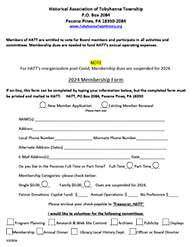October 12, 2011
RETURN TO MAIN MINUTES PAGE
ANNUAL DINNER MEETING
HISTORICAL ASSOCIATION OF TOBYHANNA TOWNSHIP
October 12, 2011
Village Squire Restaurant, Blakeslee, Pa.

Attendance: 70+
Gen. John Sullivan and the Continental Army invaded the 2011 Annual Dinner of the Historical Association of Tobyhanna Township.
More than 70 members and guests heard a professional and entertaining presentation by historian Kenn Anderson, who explained how Tobyhanna Township played a highly significant role in the success of the 1779 event known as “Sullivan’s March,” when Gen. Sullivan’s army marched through Pennsylvania during the Revolutionary War.
In full uniform and with musket in hand, Anderson shared the story of “Sullivan’s March: Building Roads and Burning Bridges.” Anderson is the author of Warrior Road, a book and audio tour of the march route.
In 1778, at the Revolutionary War raged on, the Iroquois were aligned with the British. That year large raids were conducted against American settlers in Northeast Pennsylvania, during which the Battle of Wyoming and the Wyoming Massacre saw many residents killed and their properties destroyed.
Gen. George Washington, upon learning of these significant attacks, became concerned that these enemy forces could travel from Canada through New York and Pennsylvania to Maryland, effectively dividing the Colonies. This would potentially serve as a lethal blow to the revolution.
Mr. Anderson explained how Gen. Washington ordered Gen. Sullivan to take his army north from Easton in order to eliminate this threat. But Sullivan’s army of more than 4,000 troops faced a daunting task, as there was no road from the Lehigh Valley over the Pocono plateau into the Wyoming Valley.
The mountainous terrain now known as the Poconos was a morass of thick forests and swampy bogs. Only a footpath existed. Wagons and artillery weighing tons and thousands of troops making a pounding march could never transverse this harsh environment. Bears, wolves, rattlesnakes and mosquitoes complicated the challenge.
And so Gen. Sullivan first had to order his engineering unit of 1,500 men to build a road over the plateau from Tannersville to the Wyoming Valley, straight through what is today Tobyhanna Township.
In the spring of 1779, Sullivan’s engineers blasted their way through the rock with black powder while ascending the plateau. They then faced the boggy swamp conditions. Building a corduroy road of logs laid side by side, the amazing feat was accomplished at the rate of a mile a day. That June, the road — still known today as Sullivan Trail — was ready for the march of Sullivan’s troops.
Up the mountain on today’s Sullivan Trail (Route 4007 from The Crossings area at Scotrun to Pocono Pines), the march covered much of what is today Route 940 and the Pocono Lake area, crossing the Tobyhanna Creek that today forms Pocono Lake. The road then turned north toward and up Locust Ridge, then northwest to cross the Lehigh River in proximity to today’s Route 115, through Bear Creek and into the Wilkes-Barre and Wyoming Valley area.
This required a massive effort of resources, Mr. Anderson noted, since the troops had to carry their supplies with them. Wagons were loaded with tons of food, munitions, cannon and supplies. Hundreds of oxen, mules and horses, hundreds of cattle for a constant supply of meat, and thousands of troops marched down today’s Route 940 through Tobyhanna Township.
Upon reaching the Wyoming Valley and further into southern New York state, the army destroyed the retreating Iroquois villages and food supply. In Newtown, N.Y. (east of Elmira), the Iroquois were finally confronted in battle. They quickly dispersed and retreated north. After further pursuit, General Sullivan determined that he had accomplished his mission by scattering the enemy and destroying their means of subsistence, and started his return home. Remarkably, casualties were a small number among the thousands of combatants, on both sides of the battle and pursuit.
Upon their return south, the army stopped in Pocono Pines for encampment. Diaries note that they buried their dead. As food was always at a premium for an army on the move under those conditions, this area was named “Hungry Hill.” A large memorial there commemorates Sullivan’s March and the unknown soldiers buried at this site in Tobyhanna Township.
RETURN TO MAIN MINUTES PAGE
